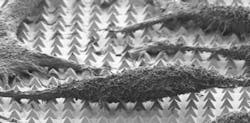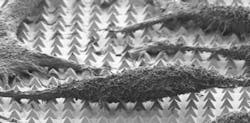Ultrafast laser-activated gold pyramids could deliver drugs, DNA into cells harmlessly
Researchers from the Harvard John A. Paulson School of Engineering and Applied Sciences (SEAS; Cambridge, MA) have developed a method that uses gold microstructures to deliver various molecules—such as drugs or DNA—into cells with high efficiency and no lasting damage.
Related: Ultrafast laser enables cell study, with big implications
In previous research, Nabiha Saklayen, a PhD candidate in the Mazur Lab at SEAS and first author of the paper describing the work, and her collaborators demonstrated that gold, pyramid-shaped microstructures do very well at focusing laser energy into electromagnetic hotspots. In this research, the team used a fabrication method called template stripping to make surfaces—about the size of a quarter—with 10 million of these tiny pyramids.
The team cultured HeLa cancer cells directly on top of the pyramids and surrounded the cells with a solution containing molecular cargo. Using ultrafast laser pulses, the team heated the pyramids until the hotspots at the tips reached a temperature of about 300°C. This very localized heating—which did not affect the cells—caused bubbles to form right at the tip of each pyramid. These bubbles gently pushed their way into the cell membrane, opening brief pores in the cell and allowing the surrounding molecules to diffuse into the cell.
Each HeLa cancer cell sat atop about 50 pyramids, meaning the researchers could make about 50 tiny pores in each cell. The team could control the size of the bubbles by controlling the laser parameters, and could control which side of the cell to penetrate. The molecules delivered into the cell were about the same size as clinically relevant cargos, including proteins and antibodies.
Next, the team plans on testing the methods on different cell types, including blood cells, stem cells, and T cells. Clinically, this method could be used in ex vivo therapies, where unhealthy cells are taken out of the body, given cargo like drugs or DNA, and reintroduced into the body.
Harvard’s Office of Technology Development has filed patent applications and is considering commercialization opportunities.
Full details of the work appear in the journal ACS Nano; for more information, please visit http://dx.doi.org/10.1021/acsnano.6b08162.

